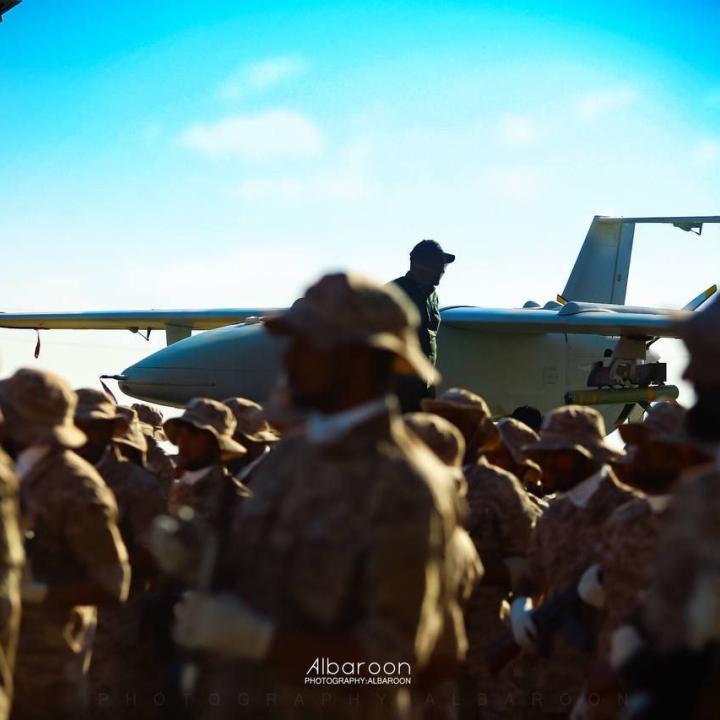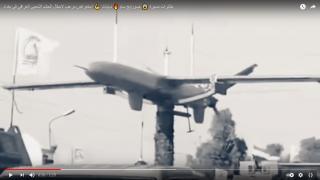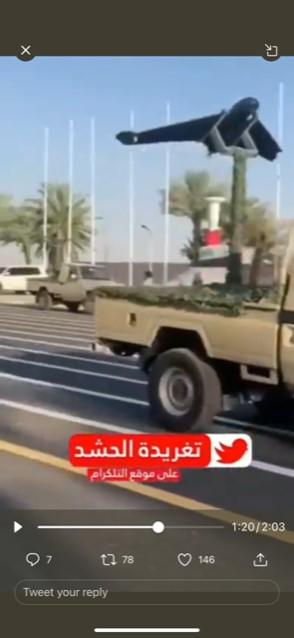
Militias Parade Under the PMF Banner (Part 1): Drone Systems

Drone systems paraded in Camp Ashraf were a show of strength, including the debut of new types of Iranian-provided airframes and control vehicles.
On June 26, the Iraqi Popular Mobilization Forces (PMF) undertook their most significant military parade so far at Camp Ashraf, Diyala. Attended by militias operating partially within the PMF rubric (e.g., the Badr Organization, Kataib Hezbollah, and Asaib Ahl al-Haq), the parade showcased a range of Iranian-provided systems intended to make the PMF look like a fully fledged military, on par with or exceeding the capabilities of Iraq's army, counterterrorism, and federal police forces. This blog entry covers drone systems showcased at the event; the second part covers Iranian-provided ground warfare systems.
The Centerpiece: Mohajer-6
Arguably the most noteworthy reveal was the first unveiling of the Iranian Qods Industries Mohajer-6 Unmanned Combat Aerial Vehicle (UCAV), portrayed as being in PMF service (Figure 1). The examples shown in the parade (still wearing Iranian serials) were armed with two Iranian-made small-diameter fragmentation bombs with electro-optical seeker heads. Mohajer-6 can carry up to four small guided bombs or missiles. While the weapon bore strong resemblance to the Iranian Qaem and Sadid families of miniature bombs, it had a configuration not seen in any Iranian version so far. Those bombs reportedly have a maximum range of 5 to 8 km and accuracy of 2.5 to 5 meters and are offered with interchangeable seeker heads—daylight television, infrared, imaging infrared, and laser-guided for “day/night precision strike capability.” The paraded configuration included a daytime television seeker with man-in-the-loop and auto search and track options, the latter making autonomous operation possible.
Compared to other large Iranian drones, Mohajer-6 has a fairly limited range and flight endurance of only 200 km and 12 hours, respectively, at a speed of 200 km/h, and that performance might be even less impressive when the drone carries its maximum 40 kg payload. The paraded examples oddly lacked any visible optical reconnaissance equipment, which might suggest that they are only intended for attack missions for now. At least three Mohajer drones were displayed on flatbed trucks.
Drone Ground Control Stations
The PMF showed at least two ground control stations (Figure 2), with long-range radars as well as long-range drone tracking and geopositioning gear.
Sahab Drone Systems
Another prominent parade participant was the Sahab loitering munition (or suicide drone, Figure 3), which is clearly a sister of the Yemeni Houthis’ Samad-1 and -2 drones. In other words, the PMF showed off a drone system that Iran has provided to another militia within the "axis of resistance." Like the Samad, Sahab is equipped with long-range transceiver antennas for precision GPS navigation. According to the UN Panel of Experts on Yemen, who examined numerous crashed examples of Samad, its extended-range version (Samad-3) can fly over 1,000 km. Six Sahab drones were shown at the parade.
Abadil-Type Systems
The PMF showed two almost identical drones that resemble parts of Iran's Abadil-3 drone but with locally manufactured variations. (Figure 4)
Between the two Abadil-type drones was a single drone that appears to be a derivative of an Iranian Pelican-2 or Sahand drone (Figure 5; credit to Adam Rawnesly for identification).
Skywalker X8 Systems
Similar to the commercial Skywalker X8 flying wing drone (Figure 6) used widely in the Middle East, the paraded examples seem to be an Iranian variant known as Chamrosh. Six X8-type systems were shown.
Analysis
The drone segment of the Ashraf parade made the desired splash due to the reveal of the Mohajer-6 and ground control station. The admission of Sahab/Samad fixed-wing drones is also interesting considering their closeness to the KAS-04 (Samad-type) systems used in at least five drone attacks on U.S. facilities since April 2021. Drones were described as being attached to the Istikhabarat (field intelligence) branch of the PMF and the Jazirah Operations Division, both of which are controlled by Kataib Hezbollah. It remains hard to ascertain how many of the displayed drones were complete and operational and which (notably the Mojaher) were fully under the control of PMF forces, as opposed to being on loan from Iran or allocated for use in Syria.
* The authors wish to thank Adam Rawnesly, Crispin Smith, and Hamdi Malik for their support in building this piece.












